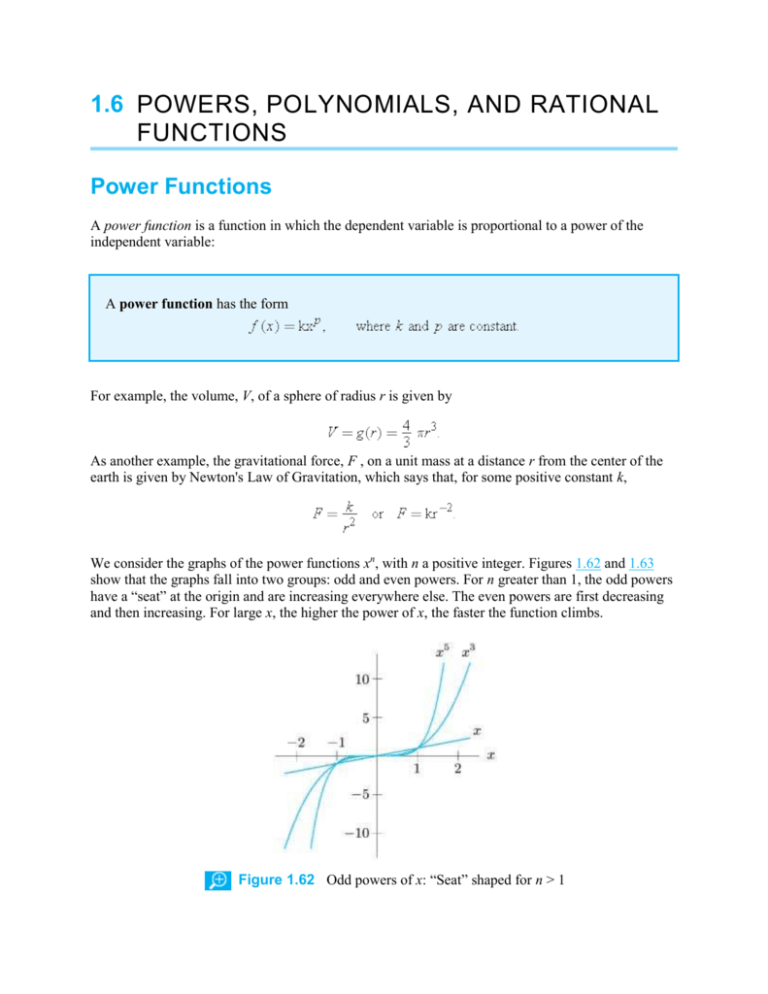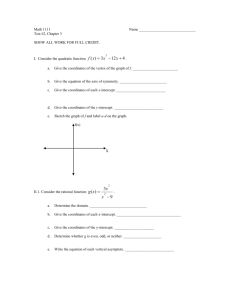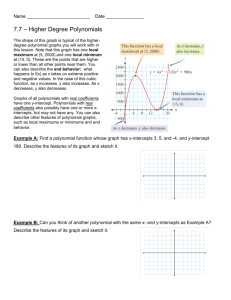
1.6 POWERS, POLYNOMIALS, AND RATIONAL
FUNCTIONS
Power Functions
A power function is a function in which the dependent variable is proportional to a power of the
independent variable:
A power function has the form
For example, the volume, V, of a sphere of radius r is given by
As another example, the gravitational force, F , on a unit mass at a distance r from the center of the
earth is given by Newton's Law of Gravitation, which says that, for some positive constant k,
We consider the graphs of the power functions xn, with n a positive integer. Figures 1.62 and 1.63
show that the graphs fall into two groups: odd and even powers. For n greater than 1, the odd powers
have a “seat” at the origin and are increasing everywhere else. The even powers are first decreasing
and then increasing. For large x, the higher the power of x, the faster the function climbs.
Figure 1.62 Odd powers of x: “Seat” shaped for n > 1
Figure 1.63 Even powers of x:
-shaped
Exponentials and Power Functions: Which Dominate?
In everyday language, the word exponential is often used to imply very fast growth. But do
exponential functions always grow faster than power functions? To determine what happens “in the
long run,” we often want to know which functions dominate as x gets arbitrarily large.
Let's consider y = 2x and y = x3. The close-up view in Figure 1.64(a) shows that between x = 2 and
x = 4, the graph of y = 2x lies below the graph of y = x3. The far-away view in Figure 1.64(b) shows
that the exponential function y = 2x eventually overtakes y = x3. Figure 1.64(c), which gives a very
far-away view, shows that, for large x, the value of x3 is insignificant compared to 2x. Indeed, 2x is
growing so much faster than x3 that the graph of 2x appears almost vertical in comparison to the more
leisurely climb of x3.
Figure 1.64 Comparison of y = 2x and y = x3: Notice that y = 2x eventually dominates
y = x3
We say that Figure 1.64(a) gives a local view of the functions' behavior, whereas Figure 1.64(c)
gives a global view.
In fact, every exponential growth function eventually dominates every power function. Although an
exponential function may be below a power function for some values of x, if we look at large enough
x-values, ax (with a > 1) will eventually dominate xn, no matter what n is.
Polynomials
Polynomials are the sums of power functions with nonnegative integer exponents:
Here n is a nonnegative integer called the degree of the polynomial, and an, an - 1, …, a1, a0 are
constants, with leading coefficient an ≠ 0. An example of a polynomial of degree n = 3 is
In this case a3 = 2, a2 = -1, a1 = -5, and a0 = -7. The shape of the graph of a polynomial depends on
its degree; typical graphs are shown in Figure 1.65. These graphs correspond to a positive coefficient
for xn; a negative leading coefficient turns the graph upside down. Notice that the quadratic “turns
around” once, the cubic “turns around” twice, and the quartic (fourth degree) “turns around” three
times. An nth degree polynomial “turns around” at most n - 1 times (where n is a positive integer), but
there may be fewer turns.
Figure 1.65 Graphs of typical polynomials of degree n
Example 1
Find possible formulas for the polynomials whose graphs are in Figure 1.66.
Figure 1.66 Graphs of polynomials
Solution
(a) This graph appears to be a parabola, turned upside down, and moved up by 4, so
The negative sign turns the parabola upside down and the +4 moves it up by 4.
Notice that this formula does give the correct x-intercepts since 0 = -x2 + 4 has
solutions x = ±2. These values of x are called zeros of f .
We can also solve this problem by looking at the x-intercepts first, which tell us
that f (x) has factors of (x + 2) and (x - 2). So
To find k, use the fact that the graph has a y-intercept of 4, so f (0) = 4, giving
or k = -1. Therefore, f (x) = -(x + 2)(x - 2), which multiplies out to -x2 + 4.
Note that f (x) = 4 - x4/4 also has the same basic shape, but is flatter near x = 0.
There are many possible answers to these questions.
(b) This looks like a cubic with factors (x + 3), (x - 1), and (x - 2), one for each
intercept:
Since the y-intercept is -12, we have
So k = -2, and we get the cubic polynomial
(c) This also looks like a cubic with zeros at x = 2 and x = -3. Notice that at x = 2 the
graph of h(x) touches the x-axis but does not cross it, whereas at x = -3 the graph
crosses the x-axis. We say that x = 2 is a double zero, but that x = -3 is a single
zero.
To find a formula for h(x), imagine the graph of h(x) to be slightly lower down,
so that the graph has one x-intercept near x = -3 and two near x = 2, say at x = 1.9
and x = 2.1. Then a formula would be
Now move the graph back to its original position. The zeros at x = 1.9 and
x = 2.1 move toward x = 2, giving
The double zero leads to a repeated factor, (x - 2)2. Notice that when x > 2, the
factor (x - 2)2 is positive, and when x < 2, the factor (x - 2)2 is still positive. This
reflects the fact that h(x) does not change sign near x = 2. Compare this with the
behavior near the single zero at x = -3, where h does change sign.
We cannot find k, as no coordinates are given for points off of the x-axis. Any
positive value of k stretches the graph vertically but does not change the zeros,
so any positive k works.
Example 2
Using a calculator or computer, graph y = x4 and y = x4 - 15x2 - 15x for -4 ≤ x ≤ 4 and for
-20 ≤ x ≤ 20. Set the y range to -100 ≤ y ≤ 100 for the first domain, and to 100 ≤ y ≤ 200,000 for the second. What do you observe?
Solution
From the graphs in Figure 1.67 we see that close up (-4 ≤ x ≤ 4) the graphs look
different; from far away, however, they are almost indistinguishable. The reason is that
the leading terms (those with the highest power of x) are the same, namely x4, and for
large values of x, the leading term dominates the other terms.
Figure 1.67 Local and global views of y = x4 and y = x4 - 15x2 - 15x
Rational Functions
Rational functions are ratios of polynomials, p and q:
Example 3
Look at a graph and explain the behavior of
.
Solution
The function is even, so the graph is symmetric about the y-axis. As x gets larger, the
denominator gets larger, making the value of the function closer to 0. Thus the graph
gets arbitrarily close to the x-axis as x increases without bound. See Figure 1.68.
Figure 1.68
Graph of
In the previous example, we say that y = 0 (i.e. the x-axis) is a horizontal asymptote. Writing “→” to
mean “tends to,” we have y → 0as x → ∞ and y → 0 as x → -∞.
If the graph of y = f (x) approaches a horizontal line y = L as x → ∞ or x → -∞, then the line
y = L is called a horizontal asymptote.10 This occurs when
If the graph of y = f (x) approaches the vertical line x = K as x → K from one side or the other,
that is, if
then the line x = K is called a vertical asymptote.
The graphs of rational functions may have vertical asymptotes where the denominator is zero. For
example, the function in Example 3 has no vertical asymptotes as the denominator is never zero. The
function in Example 4 has two vertical asymptotes corresponding to the two zeros in the
denominator.
Rational functions have horizontal asymptotes if f (x) approaches a finite number as x → ∞ or x → ∞.
We call the behavior of a function as x → ±∞ its end behavior.
Example 4
Look at a graph and explain the behavior of
Solution
Factoring gives
, including end behavior.
so x = ±1 are vertical asymptotes. If y = 0, then 3(x + 2)(x - 2) = 0 or x = ±2; these are
the x-intercepts. Note that zeros of the denominator give rise to the vertical
asymptotes, whereas zeros of the numerator give rise to x-intercepts. Substituting x = 0
gives y = 12; this is the y-intercept. The function is even, so the graph is symmetric
about the y-axis.
To see what happens as x → ±∞, look at the y-values in Table 1.15. Clearly y is
getting closer to 3 as x gets large positively or negatively. Alternatively, realize that as
x → ±∞, only the highest powers of x matter. For large x, the 12 and the 1 are
insignificant compared to x2, so
So y → 3 as x → ±∞, and therefore the horizontal asymptote is y = 3. See Figure 1.69.
Since, for x > 1, the value of (3x2 - 12)/(x2 - 1) is less than 3, the graph lies below its
asymptote. (Why doesn't the graph lie below y = 3 when -1 < x < 1?)
Table 1.15
Values of
x
±10
2.909091
±100
2.999100
±1000
2.999991
Figure 1.69
Graph of the function
Exercises and Problems for Section 1.6
Exercises
For Problems 1 and 2, what happens to the value of the function as x → ∞ and as x → -∞?
1. y = 0.25x3 + 3
2. y = 2 · 104x
3. Determine the end behavior of each function as x → ∞ and as x → -∞.
(a) f (x) = x7
(b) f (x) = 3x + 7x3 - 12x4
(c) f (x) = x-4
(d)
In Exercises 4 and 5, which function dominates as x → ∞?
4. 10 · 2x or 72,000x12
5.
or 25,000x-3
6. Each of the graphs in Figure 1.70 is of a polynomial. The windows are large enough to show end
behavior.
(a) What is the minimum possible degree of the polynomial?
(b) Is the leading coefficient of the polynomial positive or negative?
Figure 1.70
Find cubic polynomials for the graphs in Exercises 7 and 8.
7.
8.
Find possible formulas for the graphs in Exercises 9, 10, 11 and 12.
9.
10.
11.
12.
Problems
13. Which of the functions I–III meet each of the following descriptions? There may be more than
one function for each description, or none at all.
(a) Horizontal asymptote of y = 1.
(b) The x-axis is a horizontal asymptote.
(c) Symmetric about the y-axis.
(d) An odd function.
(e) Vertical asymptotes at x = ±1.
I.
II.
III.
14. The DuBois formula relates a person's surface area, s, in m2, to weight w, in kg, and height h, in
cm, by
(a) What is the surface area of a person who weighs 65 kg and is 160 cm tall?
(b) What is the weight of a person whose height is 180 cm and who has a surface area of
1.5 m2?
(c) For people of fixed weight 70 kg, solve for h as a function of s. Simplify your answer.
15. A box of fixed volume V has a square base with side length x. Write a formula for the height, h,
of the box in terms of x and V. Sketch a graph of h versus x.
16. According to Car and Driver, an Alfa Romeo going at 70 mph requires 177 feet to stop.
Assuming that the stopping distance is proportional to the square of velocity, find the stopping
distances required by an Alfa Romeo going at 35 mph and at 140 mph (its top speed).
17. Water is flowing down a cylindrical pipe of radius r.
(a) Write a formula for the volume, V, of water that emerges from the end of the pipe in one
second if the water is flowing at a rate of
(i) 3 cm/ sec
(ii) k cm/ sec
(b) Graph your answer to part (a)(ii) as a function of
(i) r, assuming k is constant
(ii) k, assuming r is constant
18. Poiseuille's Law gives the rate of flow, R, of a gas through a cylindrical pipe in terms of the
radius of the pipe, r, for a fixed drop in pressure between the two ends of the pipe.
(a) Find a formula for Poiseuille's Law, given that the rate of flow is proportional to the
fourth power of the radius.
(b) If R = 400 cm3/ sec in a pipe of radius 3 cm for a certain gas, find a formula for the rate
of flow of that gas through a pipe of radius r cm.
(c) What is the rate of flow of the same gas through a pipe with a 5 cm radius?
19. The height of an object above the ground at time t is given by
where v0 is the initial velocity and g is the acceleration due to gravity.
(a) At what height is the object initially?
(b) How long is the object in the air before it hits the ground?
(c) When will the object reach its maximum height?
(d) What is that maximum height?
20. A pomegranate is thrown from ground level straight up into the air at time t = 0 with velocity 64
feet per second. Its height at time t seconds is f (t) = -16t2 + 64t. Find the time it hits the ground
and the time it reaches its highest point. What is the maximum height?
21.
(a) If f (x) = ax2 + bx + c, what can you say about the values of a, b, and c if:
(i) (1, 1) is on the graph of f (x)?
(ii) (1, 1) is the vertex of the graph of f (x)? [Hint: The axis of symmetry is x = b/(2a).]
(iii) The y intercept of the graph is (0, 6)?
(b) Find a quadratic function satisfying all three conditions.
22. Values of three functions are given in Table 1.16, rounded to two decimal places. One function
is of the form y = abt, one is of the form y = ct2, and one is of the form y = kt3. Which function is
which?
Table 1.16
t
f (t)
t
g(t)
t
h(t)
2.0 4.40 1.0
3.00
0.0
2.04
2.2 5.32 1.2
5.18
1.0
3.06
2.4 6.34 1.4
8.23
2.0
4.59
2.6 7.44 1.6 12.29 3.0
6.89
2.8 8.62 1.8 17.50 4.0 10.33
3.0 9.90 2.0 24.00 5.0 15.49
23. Values of three functions are given in Table 1.17, rounded to two decimal places. Two are power
functions and one is an exponential. One of the power functions is a quadratic and one a cubic.
Which one is exponential? Which one is quadratic? Which one is cubic?
Table 1.17
x
f (x)
x
g(x)
x
k(x)
8.4
5.93 5.0 3.12 0.6
3.24
9.0
7.29 5.5 3.74 1.0
9.01
9.6
8.85 6.0 4.49 1.4 17.66
10.2 10.61 6.5 5.39 1.8 29.19
10.8 12.60 7.0 6.47 2.2 43.61
11.4 14.82 7.5 7.76 2.6 60.91
24. A cubic polynomial with positive leading coefficient is shown in Figure 1.71 for -10 ≤ x ≤ 10
and -10 ≤ y ≤ 10. What can be concluded about the total number of zeros of this function? What
can you say about the location of each of the zeros? Explain.
Figure 1.71
25. After running 3 miles at a speed of x mph, a man walked the next 6 miles at a speed that was 2
mph slower. Express the total time spent on the trip as a function of x. What horizontal and
vertical asymptotes does the graph of this function have?
26. Match the following functions with the graphs in Figure 1.72. Assume 0 < b < a.
(a)
(b)
(c)
(d)
Figure 1.72
27. Consider the point P at the intersection of the circle x2 + y2 = 2a2 and the parabola y = x2/a in
Figure 1.73. If a is increased, the point P traces out a curve. For a > 0, find the equation of this
curve.
Figure 1.73
28. Use a graphing calculator or a computer to graph y = x4 and y = 3x. Determine approximate
domains and ranges that give each of the graphs in Figure 1.74.
Figure 1.74
29. The rate, R, at which a population in a confined space increases is proportional to the product of
the current population, P, and the difference between the carrying capacity, L, and the current
population. (The carrying capacity is the maximum population the environment can sustain.)
(a) Write R as a function of P.
(b) Sketch R as a function of P.
30. When an object of mass m moves with a velocity v that is small compared to the velocity of
light, c, its energy is given approximately by
If v is comparable in size to c, then the energy must be computed by the exact formula
(a) Plot a graph of both functions for E against v for 0 ≤ v ≤ 5 · 108 and 0 ≤ E ≤ 5 · 1017.
Take m = 1 kg and c = 3 · 108 m/sec. Explain how you can predict from the exact formula
the position of the vertical asymptote.
(b) What do the graphs tell you about the approximation? For what values of v does the first
formula give a good approximation to E?
Copyright © 2009 John Wiley & Sons, Inc. All rights reserved.









